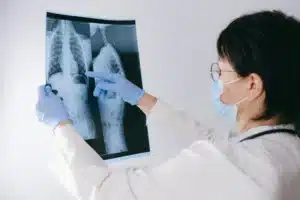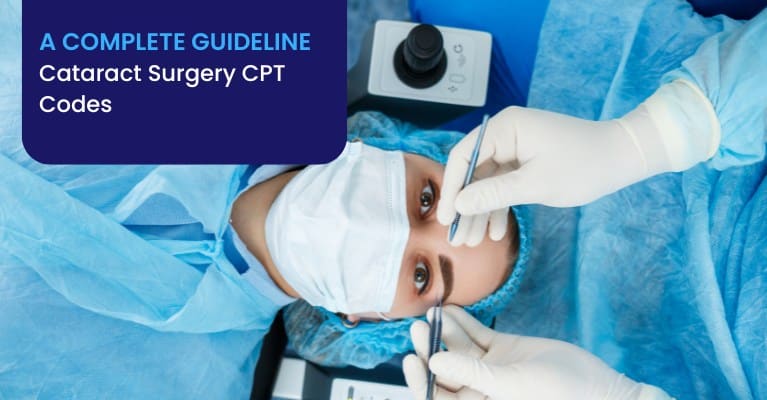
Menu

Healthcare professionals might often search for reliable information about CPT codes for cataract surgery to ensure accurate billing and compliance. Understanding these codes is crucial for precise billing directly affecting reimbursement and adherence to medical standards.
Cataract surgery involves several coding options that can be complex for medical billers and coders. The correct choice of CPT code, from 66840 for simple lens extraction to 66984 for extracapsular cataract removal with an intraocular lens implant, and knowing when to use codes like 66982 for complex procedures compared to standard codes is critical for optimal billing results.
Today I shared the guidelines for cataract surgery CPT codes that assist ophthalmologists, and healthcare administration professionals in enhancing operational efficiency and patient care to prevent common issues such as underbilling or claim denials.
CPT codes are essential for accurate billing and efficient management in cataract surgery, ensuring healthcare providers receive proper reimbursement and maintain regulatory compliance.
To assist health professionals in healthcare billing, CPT codes are important with the standardized documentation and billing of medical procedures. In the context of cataract removal, these codes provide a systematic way to communicate the specific methods and technologies used during surgery to insurance providers, ensuring accurate and timely reimbursement.
For ophthalmology professionals, understanding and utilizing the correct CPT codes is not just a billing practice but a critical component of clinical operations. These codes enable practitioners to:
Cataract surgery CPT codes help simplify billing processes and enhance accuracy in medical claims, particularly in ophthalmology.
Basic cataract surgeries are commonly billed using several CPT codes based on the procedure specifics. For instance:
| CPT Codes | Description |
| 66984 | Extracapsular cataract removal with insertion of intraocular lens prosthesis (1-stage procedure), manual or mechanical technique (e.g., irrigation and aspiration or phacoemulsification). This code is used for standard cataract surgeries. |
| 66850 | Removal of lens material; phaco-fragmentation technique (mechanical or ultrasonic) (e.g., phacoemulsification), with aspiration. This code is used for standard phacoemulsification procedures. |
| 66940 | Removal of lens material; extracapsular (other than 66840, 66850, 66852). This code is used for extracapsular techniques other than the common ones. |
| 66983 | Intracapsular cataract extraction with insertion of intraocular lens prosthesis (1-stage procedure). This code is used for intracapsular extraction with lens implantation. |
| 66840 | Removal of lens material; aspiration technique, 1 or more stages. This code is used for cataract removal using the aspiration technique. |
Complex cataract surgeries involve more intricate procedures that may require advanced surgical skills or specialized equipment. Relevant CPT codes include:
| CPT Code | Description |
| 66982 | Extracapsular cataract removal with insertion of intraocular lens prosthesis (1-stage procedure), manual or mechanical technique (e.g., irrigation and aspiration or phacoemulsification), complex, requiring devices or techniques not generally used in routine cataract surgery (e.g., iris expansion device, suture support for an intraocular lens, or primary posterior capsulorhexis) or performed on patients in the amblyogenic developmental stage. |
| 66852 | Removal of lens material; pars plana approach, with or without vitrectomy. This code is used for cataract removal involving a pars plana approach. |
| 66987 | Cataract removal with endoscopic cyclophotocoagulation. This code is used for cataract surgery combined with endoscopic cyclophotocoagulation, typically for patients with coexisting glaucoma. |
| 66988 | Extracapsular cataract removal with insertion of intraocular lens prosthesis (1-stage procedure), manual or mechanical technique (e.g., irrigation and aspiration or phacoemulsification), with endoscopic cyclophotocoagulation. |
Here we discuss common coding challenges faced by medical billers and coders in cataract surgery, providing solutions to improve accuracy and ensure efficient processing of claims.
Modifiers play a crucial role in cataract surgery coding, helping to clarify the circumstances of the procedure and ensuring appropriate reimbursement.
| Modifier | Description |
| -RT | Right side (used to indicate procedures performed on the right eye) |
| -LT | Left side (used to indicate procedures performed on the left eye) |
| -50 | Bilateral procedure (used when the same procedure is performed on both eyes during the same session) |
| -51 | Multiple procedures (used when multiple procedures are performed during the same surgical session) |
| -22 | Increased procedural services (indicates that the work performed was substantially greater than typically required) |
| -79 | Unrelated procedure or service by the same physician during the postoperative period (used if a second procedure is performed during the postoperative period that is not related to the initial procedure) |
We discuss some strategies to overcome common billing errors in cataract surgery:
CPT codes for cataract surgery aim to enhance the efficiency and accuracy of billing practices for ophthalmologists, healthcare administrators, and medical billers. Professionals can use the correct CPT codes outlined in this blog to ensure that procedures are billed correctly, facilitating prompt and accurate reimbursement. This resource helps streamline billing processes, prevents common billing errors, and supports the delivery of excellent patient care, making it an essential tool for anyone involved in the administration of cataract surgery.



